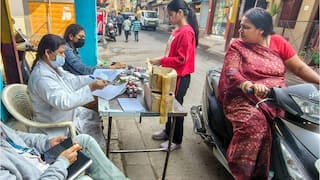World Immunization Week 2022: BCG, OPV, Pentavalent, PCV – Complete List Of Vaccines For Children
The Union government, under the Universal Immunization Programme, is providing vaccination to prevent 12 vaccine-preventable diseases.

New Delhi: It is important to get vaccinated on time throughout childhood because vaccination helps provide immunity before children are exposed to potentially life-threatening diseases.
People must follow the recommended vaccination schedule in their country because delaying a vaccine increases the child's vulnerability to disease.
Why Are Vaccines Important For Children?
Vaccines save lives and protect children against diseases that can cause serious harm or death, especially in infants whose immune system is developing.
World Immunization Week is celebrated annually in the last week of April, to highlight the importance of vaccines and how immunisation helps protect people from vaccine-preventable diseases.
The Immunization Programme in India is one of the key interventions for protection of children from life-threatening conditions, which are preventable, and one of the largest immunisation programmes in the world. It was introduced in 1978, and gained momentum in 1985, after which it was expanded as the Universal Immunization Programme (UIP).
The Union government, under the Universal Immunization Programme, is providing vaccination to prevent 12 vaccine-preventable diseases. Vaccines for nine diseases are being provided nationally. These diseases are diphtheria, pertussis, tetanus, polio, measles, Rubella, severe form of childhood tuberculosis, hepatitis B, and meningitis and pneumonia caused by the bacterium Haemophilus influenzae type b (Hib).
The diseases for which vaccines are available sub-nationally are Rotavirus diarrhoea, pneumococcal pneumonia, and Japanese encephalitis.
An infant who receives all the vaccines as per the National Immunization Schedule within a year since birth is said to be fully immunised.
Here is the complete list of vaccines which are administered to children under the Universal Immunization Programme.
Vaccines At Birth
The vaccines which are given at birth under the Universal Immunization Programme include BCG, Hepatitis B birth dose, and OPV birth dose.
BCG
BCG, which stands for bacille Calmette-Guerin, is a vaccine for tuberculosis (TB) disease, and is used to prevent childhood tuberculous meningitis and miliary disease, according to the Centers for Disease Control and Prevention (CDC).
Tuberculous meningitis is a form of meningitis characterised by inflammation of membranes or meninges around the brain or spinal cord, and is caused by the bacterium Mycobacterium tuberculosis.
Miliary tuberculosis is also caused by Mycobacterium tuberculosis, and is a life-threatening form of tuberculosis that occurs due to the spread of tubercle bacilli to the lungs and other organs.
The BCG vaccine could be given at birth or before the child is a year old. It is an intradermal vaccine, which means it is delivered into the outer layers of the skin. BCG vaccination is given as an injection into the left arm, and usually leaves a small scar.
The standard dose of the vaccine is 0.1 millilitre for children less than a year old, and 0.05 millilitre for infants less than a month old.
Hepatitis B Birth Dose
Hepatitis B is a serious disease caused by the hepatitis B virus (HBV), which attacks the liver, and can cause life-long infection, cirrhosis or scarring of the liver, live cancer, liver failure, and death.
Shortly after birth, the infant should receive the first dose of the Hepatitis B vaccine.
The shot reduces the risk of the baby getting the disease from his or her family members who may not know they are infected with hepatitis B.
According to the CDC, three doses of Hepatitis B vaccine are recommended for children by doctors as the best way for protection against hepatitis B.
However, the Hepatitis B vaccine can have side effects such as low fever, or soreness of the arm from the shot.
The Hepatitis B vaccine should be given at birth, or as early as possible within 24 hours. The standard dose of the vaccine at birth is 0.5 millilitre. It is injected as an intramuscular vaccine, which means it is delivered deep into the muscles, allowing the medication to be absorbed into the bloodstream quickly.
The Hepatitis B vaccine should be administered in the upper arm into the deltoid muscle (thick triangular muscle covering the shoulder joint) or the anterolateral aspect of the mid-thigh, because injection into the buttock is associated with decreased immunogenicity.
OPV Birth Dose
The oral polio vaccine (OPV) is a vaccine to protect against polio, or poliomyelitis.
OPV is the predominant vaccine used in the fight to eradicate polio. The vaccine consists of a mixture of live attenuated poliovirus strains of each of three serotypes of poliovirus, namely type 1, type 2, and type 3.
OPV produces antibodies in the blood to all the three types of poliovirus, according to the World Health Organization. This is known as humoral or serum immunity, which, in the event of infection with poliovirus naturally, protects the child against polio paralysis by preventing the spread of poliovirus to the nervous system. The OPV strains also produce a local immune response in the lining of the intestines or mucous membrane, which is the primary site for poliovirus multiplication. The antibodies produced in the lining prevent the multiplication of subsequent infections of 'wild' or naturally occuring virus.
OPV is administered at birth or as early as possible within the first 15 days. Two drops are administered to the child orally.
Six Weeks After Birth
The vaccines administered to children six weeks after birth are OPV-1, Pentavalent-1, Rotavirus Vaccine-1 (RVV-1), Fractional dose of Inactivated Polio Vaccine-1 (fIPV-1), and Pneumococcal Conjugate Vaccine-1 (PCV-1).
OPV-1
The first dose of OPV is followed by another dose six weeks after birth. The vaccine administered is called OPV-1.
Pentavalent-1
The pentavalent vaccine provides protection to a child from five life-threatening diseases — diphtheria, pertussis, tetanus, hepatitis B, and Hib, according to the World Health Organization.
DPT (Diphtheria + Pertussis + Tetanus) and Hepatitis B are already part of routine immunisation in India. The Hib vaccine is a new addition. The combination is known as pentavalent.
Hib vaccine is used to provide protection against serious diseases caused by the bacterium Haemophilus influenzae type b.
Pentavalent vaccine is convenient because not only does it reduce the number of pricks, but also provides protection from all five diseases.
Pentavalent vaccine is administered six weeks after birth. The vaccine comes in a liquid form in a vial which contains 10 doses. A standard dose of 0.5 millilitres is administered as an intramuscular injection in the anterolateral aspect of the mid-thigh.
Hib is a bacterium that causes severe infections such as bacterial meningitis, pneumonia, septicaemia, septic arthritis, epiglottis, among others. Bacterial meningitis is a disease which causes inflammation of the membranes that cover and protect the brain and the spinal cord.
Pneumonia causes inflammation of the lungs.
Septicaemia is a disease caused by the presence of pathogenic bacteria in the blood.
Septic arthritis is the inflammation of joints.
Epiglottis is a disease characterised by the inflammation of the area around vocal cords, and obstruction of the airway.
The reason why Hib vaccine is given as a pentavalent vaccine and not separately is that the schedule for DPT, Hepatitis B, and Hib is the same at six, 10, and 14 weeks, which means that a child will get three pricks at the same time if the three vaccines are given separately.
Therefore, to reduce the number of pricks, pentavalent vaccine is administered.
Rotavirus Vaccine (RVV-1)
The Rotavirus vaccine was introduced in India in March 2016. The vaccine provides protection against rotavirus disease. According to the CDC, rotavirus causes severe, watery diarrhoea, mostly in infants and young children.
Rotavirus vaccine is administered by putting five drops in the child's month. The first dose is given six weeks after birth.
Fractional Dose Of Inactivated Polio Vaccine (fIPV)-1
This is a fractional dose (one-fifth) of the inactivated polio vaccine (IPV), which provides protection against polio, or poliomyelitis. IPV was developed in 1955 by American virologist Jonas Salk, and is also called the Salk vaccine.
IPV consists of inactivated or killed poliovirus strains of all three poliovirus types. The (fIPV)-1 vaccine is administered as an intradermal injection six weeks after birth.
A standard dose of 0.1 millilitre is administered. It was previously administered intramuscularly, but due to shortages in vaccine supplies and higher costs of vaccines, the fractional dose of IPV was invented, which is administered intradermally.
The vaccine produces antibodies in the blood against all the three types of poliovirus.
IPV was introduced in India under the Universal Immunization Programme, as part of the Global Polio Endgame Strategy (GPEI) in November 2015. It was initially introduced in six states, and was subsequently expanded across the country by April 2016.
Pneumococcal Conjugate Vaccine (PCV)-1
Pneumococcal conjugate vaccine (PCV) helps protect against bacteria that cause pneumococcal disease, which refers to any disease caused by pneumococcal bacteria.
These bacteria cause diseases such as pneumonia, ear infections, sinus infections, meningitis, and bacteremia, which is infection of the blood.
PCV was launched in India in May 2017 to reduce infant mortality and morbidity caused by pneumococcal pneumonia.
It is available in selected states and districts.
(PCV)-1 is administered to children six weeks after birth. A dose of 0.5 millilitre is given as an intramuscular injection in the anterolateral aspect of the mid-thigh.
10 Weeks After Birth
The vaccines administered to children 10 weeks after birth are OPV-2, Pentavalent-2, and RVV-2. OPV-2 is administered orally in the form of two drops, while 0.5 millilitre of Pentavalent-2 is administered as an intramuscular injection. RVV-2 is administered orally in the form of five drops.
14 Weeks After Birth
The vaccines administered to children 14 weeks after birth are OPV-3, Pentavalent-3, fIPV-2, RVV-3 and PCV-2.
Nine To 12 Months
The vaccines administered to children who are nine to 12 months old are Measles & Rubella (MR)-1, JE-1, and PCV Booster.
Children who have been vaccinated against Measles and Rubella, are given a dose of Vitamin A at nine months. A dose of 1 millilitre is administered orally.
Measles & Rubella (MR)-1
The Measles & Rubella (MR) vaccine is given for active immunisation against Measles and Rubella in infants, children, adolescents, and young adults at risk. Measles is an acute viral respiratory illness caused by Measles morbillivirus, and is characterised by early symptoms such as fever (as high as 105 degrees Fahrenheit), malaise, cough, coryza (acute inflammation of mucous membrane of nose), and conjunctivitis, and rashes.
Rubella or German Measles is a contagious disease caused by the Rubella virus. The symptoms of the disease include a low-grade fever, sore throat, and a rash that begins on the face and spreads to the rest of the body. It is best known by its distinctive red rash, and is also known as three-day measles.
Rubella can cause serious problems for unborn babies whose mothers become infected during pregnancy.
Rubella is not as infectious or as severe as measles.
The side effects of the MR vaccine are mostly mild and transient, according to the Serum Institute of India (SII). Slight pain and tenderness at the site of infection may take place, followed by mild fever.
The first dose of the vaccine is administered to a child who is between nine to 12 months old. A dose of 0.5 millilitre is administered subcutaneously in the right upper arm.
The MR vaccine was introduced in India in a phased manner in 2017, as the country is committed to the goal of measles elimination and rubella control.
JE-1 Vaccine
The JE vaccine provides protection against Japanese encephalitis, which is a mosquito-borne zoonotic viral disease, caused by the Japanese encephalitis virus (JEV).
Common symptoms of Japanese encephalitis include headache, fever, mental confusion, and delirium, which is a mental state in which one feels confused, disoriented, and is unable to think clearly.
Japanese encephalitis primarily affects children.
The JE-1 vaccine is administered to children between nine to 12 months old. When a live attenuated vaccine is used, a dose of 0.5 millilitre is given subcutaneously in the left upper arm. A live attenuated vaccine is a vaccine that uses a weakened or attenuated form of the pathogen. These vaccines create a strong and long-lasting immune response because they are very similar to the natural infection they help prevent.
A killed vaccine is administered intramuscularly in the anterolateral aspect of the mid-thigh. A dose of 0.5 millilitre is given. A killed vaccine, also known as an inactivated vaccine, consists of particles of virus, bacteria, or other pathogens that were cultured, and then killed to destroy their disease-causing capacity. The whooping cough or pertussis vaccine is an example of a killed vaccine.
The JE vaccine is available only in endemic districts of India.
16 to 24 Months Old
The vaccines administered to children 16 to 24 months old are MR-2, JE-2, Diphtheria, Pertussis & Tetanus (DPT)-Booster 1, and OPV-Booster.
MR-2 and JE-2 are the second doses of the MR and JE vaccines respectively.
Diphtheria, Pertussis, & Tetanus (DPT)-1 Booster
The Diphtheria, Pertussis, & Tetanus (DPT)-1 booster is administered to children 16 to 24 months old.
Diphtheria is a serious infection caused by strains of a bacterium called Corynebacterium diphtheriae, which make toxins, according to the CDC. The toxin can lead to difficulty breathing, heart failure, paralysis, and even death.
Pertussis or whooping cough is a highly contagious respiratory disease caused by the bacterium Bordetella pertussis. The disease is characterised by uncontrollable, violent coughing which often makes it hard for the person to breathe. It is marked by a severe cough followed by a high-pitched intake of breath, which results in a "whooping" sound.
Whooping cough was considered a childhood disease before the vaccine was developed.
Tetanus is an infection caused by bacteria called Clostridium tetani, and is usually fatal. The bacteria produce a toxin after invading the body of the host.
The toxin causes painful muscle contractions. Tetanus is also known as "lockjaw", as it often causes a person's neck and jaw muscles to lock, making it hard to open the mouth or swallow.
It is the toxins produced by the causative organisms of diphtheria, pertussis, and tetanus which primarily cause symptoms.
The DPT-1 booster is administered intramuscularly in the anterolateral aspect of the mid-thigh. A dose of 0.5 millilitre is given.
MR Second Dose
The second dose of the MR vaccine is administered to children 16 to 24 months old. A dose of 0.5 millilitre is given subcutaneously in the right upper arm.
OPV Booster
The OPV booster is administered orally to children 16 to 24 months old in the form of two drops.
JE-2
The second dose of the JE vaccine is given to children 16 to 24 months old. A 0.5 millilitre dose of the live attenuated vaccine is administered subcutaneously in the left upper arm. Meanwhile, a 0.5 millilitre dose of the killed vaccine is administered intramuscularly in the anterolateral aspect of the mid-thigh.
Vitamin A Second To Ninth Doses
The second dose of vitamin A is administered to children between 16 to 18 months old. Then, one dose is administered every six months up to the age of five years, till a total of nine doses are complete.
A dose of two millilitres is administered orally. The doses can be administered during biannual rounds.
Five To Six Years Old
The DPT Booster-2 is administered to children between five to six years of age.
10 Years Old
The Tetanus & adult diphtheria (Td) vaccine is administered to 10-year-old children. The Td vaccine is a combination of tetanus and diphtheria with lower concentration of diphtheria antigen as recommended for older children and adults.
The Td vaccine protects only from tetanus and diphtheria, as adults are less likely than babies to contract whooping cough. Adults need the booster every 10 years. The Td vaccine is administered intramuscularly in the upper arm. A dose of 0.5 millilitre is given.
16 Years Old
The Td vaccine is also given to 16-year-old children. It is administered in the same manner in which 10-year-old children are inoculated.
Vaccines For Pregnant Women
Pregnant women are given the Td vaccine early in the pregnancy, and four weeks after the first dose. A dose of 0.5 millilitre is administered intramuscularly in the upper arm.
The Tetanus Toxoid (TT) vaccine has been replaced with the Td vaccine under the Universal Immunization Programme to limit the waning immunity against diphtheria in older age groups.
Check out below Health Tools-
Calculate Your Body Mass Index ( BMI )
Calculate The Age Through Age Calculator
Related Video
Southern Rising Summit 2024: How Important is Self-Awareness? Insights from Anu Aacharya | ABP LIVE






































